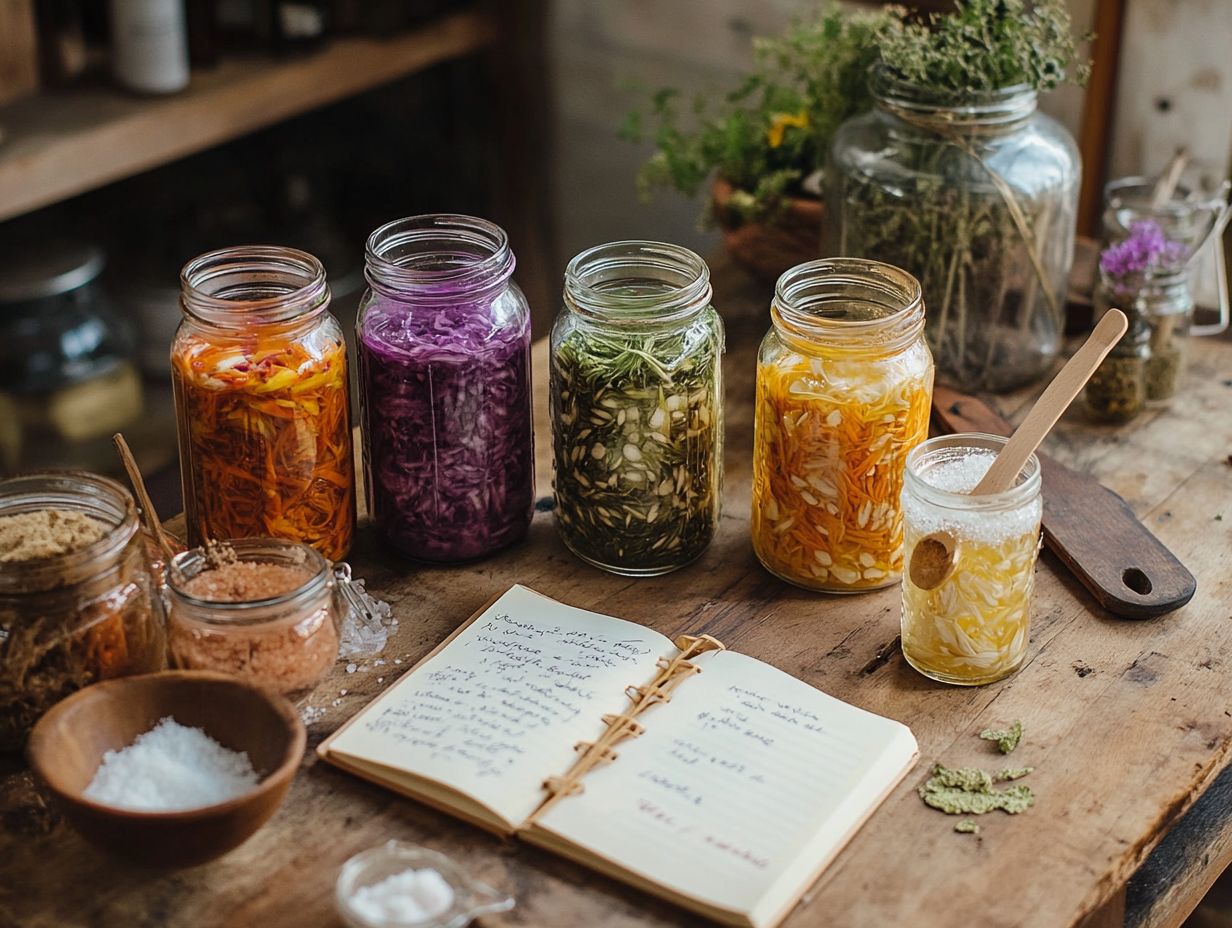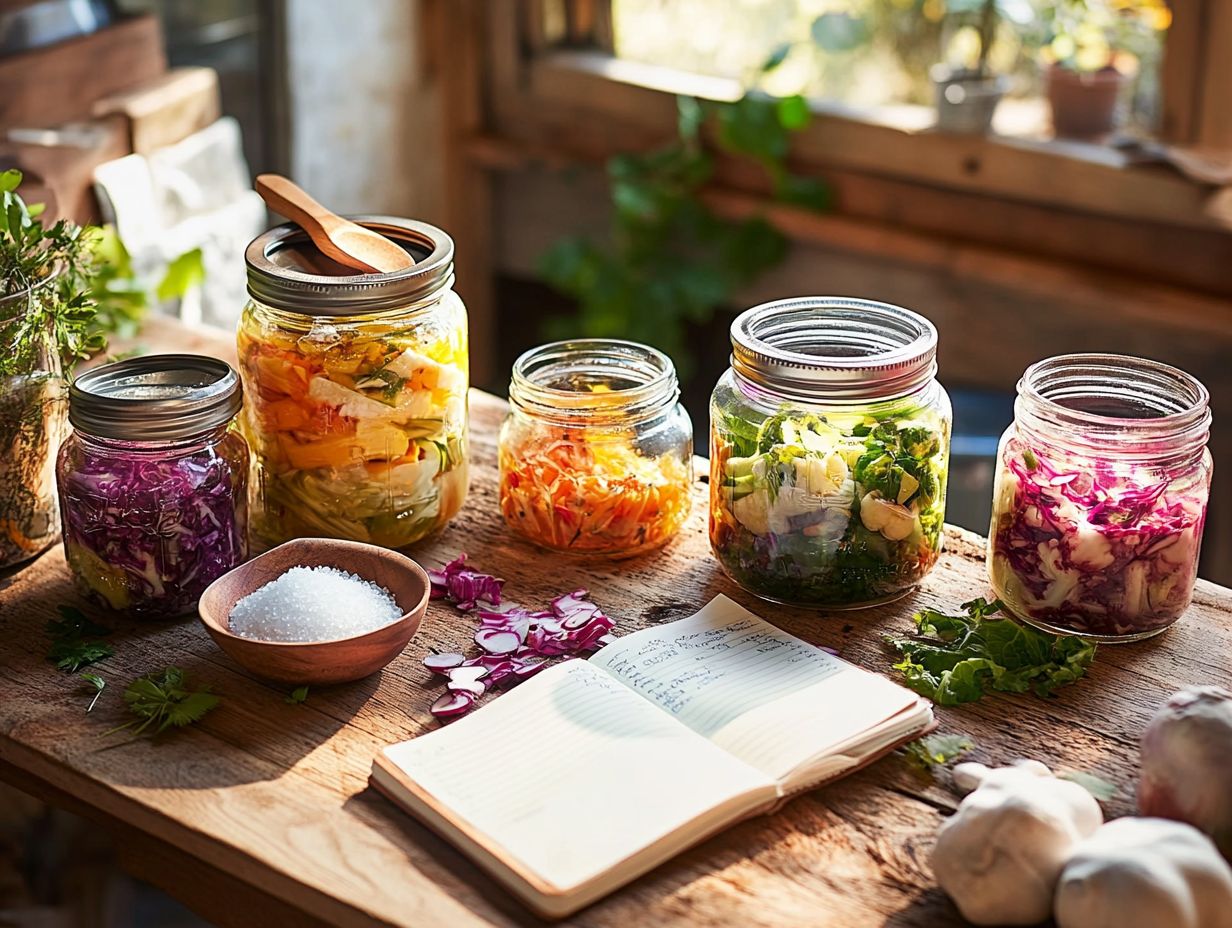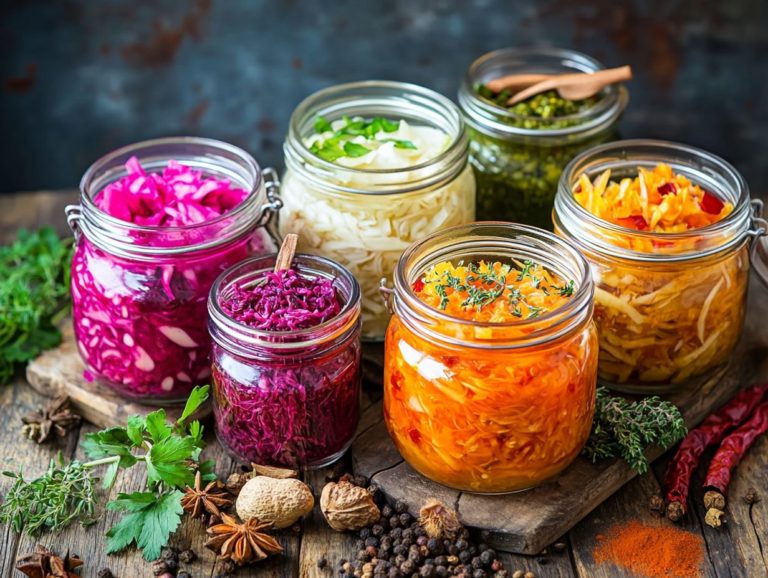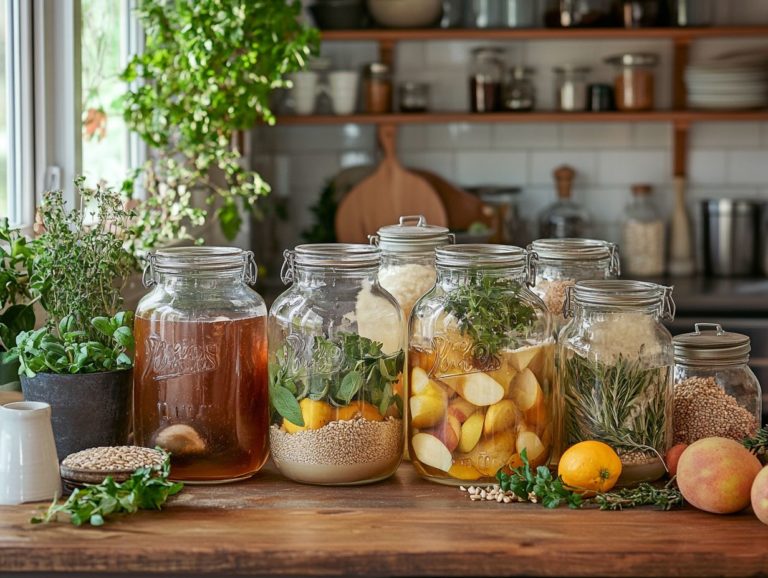5 Essential Tips for Successful Fermentation
Fermentation is an intriguing and rewarding culinary art that elevates simple ingredients into vibrant, flavorful foods. Grasping the fundamentals of fermentation techniques can significantly enhance your fermentation journey and ensure fermentation success.
To achieve successful fermentation, consider these five essential tips:
- Start with high-quality ingredients.
- Understand the fermentation process and the role of good bacteria that help preserve the food.
- Embrace the nuances of timing, temperature, and fermentation duration.
- Familiarize yourself with common pitfalls to avoid for optimal fermentation safety.
- Explore innovative ways to seamlessly incorporate these healthful foods into your diet, such as homemade probiotics and vegetable recipes.
Embrace the adventure and unlock the secrets of fermentation!
Contents
- Key Takeaways:
- 1. Use Quality Ingredients
- 2. Keep a Clean and Sanitized Environment
- 3. Monitor Temperature and Humidity
- What Is Fermentation and Why Is It Important?
- What Are the Different Types of Fermentation?
- What Are the Common Mistakes to Avoid in Fermentation?
- Frequently Asked Questions
- What are the 5 essential tips for successful fermentation?
- How important is temperature control in fermentation?
- Why is sterilization important in fermentation?
- What role do ingredients play in successful fermentation?
- Do I need special equipment for fermentation?
- How often should I monitor the fermentation process?
Key Takeaways:

- Use fresh ingredients and high-quality vegetables to ensure a successful fermentation process and a delicious end product.
- Keep a clean and sanitized environment to prevent contamination and ensure the growth of beneficial bacteria.
- Monitor temperature and humidity closely to maintain optimal conditions for fermentation.
1. Use Quality Ingredients
Using quality ingredients is absolutely essential in the fermentation process. Fresh vegetables, the perfect salt percentage, and clean brine not only elevate the flavors of your fermented creations but also significantly enhance their health benefits, transforming them into nutritious probiotic foods that support digestion and overall well-being. Utilizing proper fermentation techniques, like lacto-fermentation, can enhance these benefits.
When you select vegetables for fermentation, remember that freshness is key. Opt for crisp, vibrant cabbage for your sauerkraut or firm radishes for your kimchi. These choices will yield a more robust fermentation compared to wilted or overly mature ingredients. This top-notch produce ensures that flavors develop harmoniously, allowing beneficial microflora to thrive.
Salt plays a crucial role as a preservative, carefully controlling the fermentation process by inhibiting unwanted bacteria while fostering the growth of the good guys. For example, the right salt concentration will encourage lactobacilli to flourish in your kimchi, enhancing that iconic tang, while also preserving the vegetables’ crunchiness and vibrancy. Adding a fermentation weight can ensure the vegetables stay submerged in brine. These qualities are what make both sauerkraut and kimchi beloved staples in the world of fermented foods.
2. Keep a Clean and Sanitized Environment
Maintaining a pristine and sanitized environment is essential in the fermentation process, as it prevents unwanted microbial activity. By doing so, you enable beneficial lactic acid bacteria to flourish while keeping harmful bacteria at bay, ultimately ensuring a successful and safe fermentation.
As you embark on your fermentation journey, it s crucial to understand that the quality of your final product heavily relies on the cleanliness of all your equipment, including fermentation jars and utensils. Each surface should be meticulously cleansed with hot, soapy water, followed by a sanitizing solution to eradicate any lingering bacteria that could jeopardize your batch. This step is vital for cleaning up after fermentation and ensuring high quality.
This diligent approach to sanitation isn t merely a suggestion; it is the foundation of safe fermentation practices. When you prioritize cleanliness, the risk of spoiled or contaminated products is significantly reduced, resulting in flavors that are not only vibrant but also entirely safe for consumption. This ensures fermentation consistency.
Dive into the world of fermentation today! Discover flavors that will transform your meals and health!
3. Monitor Temperature and Humidity
Monitoring temperature and humidity levels during the fermentation process is crucial. These elements shape your fermentation timeline and influence microbial activity, which ultimately affects the quality and flavor of your fermented vegetables. Using a fermentation gauge can help track these variables accurately.
For the best results, aim for an ideal temperature range of 60 F to 75 F (15 C to 24 C). Keep humidity levels around 60-70%. Cooler temperatures slow down microbial activity, which can extend fermentation time and lead to a milder taste something desirable for certain products. Conversely, higher temperatures can speed up fermentation but risk introducing off-flavors due to the dominance of wild yeast or bacteria.
To cultivate the perfect environment for your fermentation journey, consider investing in monitoring devices that offer real-time temperature and humidity readings. Placing your fermentation jars in a dark, stable room or within a temperature-controlled container can help maintain those ideal conditions, ensuring consistently delightful results every time!
4. Follow a Proper Fermentation Process

Following a proper fermentation process is essential for achieving your desired results in vegetable fermentation. This involves using the right techniques to create an oxygen-free environment that nurtures beneficial fermentation cultures while preserving the brine’s integrity. An airlock can help maintain this environment.
To start, prepare the brine correctly. It should have a perfect balance of salt and water to promote the growth of the desired microorganisms. This brine acts as a protective barrier against unwanted bacteria while encouraging the fermentation cultures to flourish and ensure food preservation.
Sealing your fermentation vessels with airlocks is vital for maintaining an oxygen-free environment. Airlocks allow carbon dioxide to escape while keeping oxygen out, thus preventing spoilage. This technique is essential for ensuring fermentation quality and safety.
As fermentation progresses, cultures break down sugars to develop exciting flavors and textures. This careful process is crucial for consistent results!
5. Be Patient and Allow Enough Time for Fermentation
Patience is paramount on your fermentation journey. Allowing ample time for fermentation dramatically enhances the complexity of flavors and improves the textures of your fermented vegetables. This ultimately leads to your fermentation success and reduces food waste.
Recognizing that different vegetables require varying fermentation durations is essential. For example, tender vegetables like cucumbers may need only a few days, while heartier options such as carrots thrive with a longer fermentation period. Adjusting fermentation time based on the vegetable type is crucial.
As time unfolds, beneficial bacteria work their magic, breaking down sugars and creating a symphony of flavors that cannot be hurried. This gradual transformation sharpens taste and cultivates a satisfying crunch, elevating the overall experience. This is a key aspect of fermentation experiments.
Embracing this timeline is crucial; the rewards of patience are undeniably worth the wait!
What Is Fermentation and Why Is It Important?
Fermentation is a remarkable natural metabolic process where microorganisms, such as lactic acid bacteria, transform sugars into acids, gases, or alcohol. This results in a range of nutritious fermented foods that not only elevate flavors but also provide many health benefits, including improved digestion and enhanced food preservation. Fermented recipes are truly an essential technique in the culinary world.
This captivating process has roots that stretch back thousands of years. Early civilizations skillfully harnessed fermentation to extend the life of their food supplies. From ancient Egypt, where bread and beer formed the backbone of sustenance, to traditional Asian practices of crafting kimchi and soy sauce, fermentation has woven itself into the fabric of societies across the globe. Understanding the history of fermentation adds depth to your practice.
But fermentation is more than just a preservation method. Consuming fermented foods like yogurt, kombucha, and sauerkraut has been associated with improved gut health, boosted immunity, and enhanced nutrient absorption. These delicious additions to your modern diet are not merely treats; they are powerful allies in your journey toward health and wellness. Including probiotic bacteria in your diet can further amplify these benefits.
What Are the Different Types of Fermentation?
You ll find a variety of fermentation methods at your fingertips, including lacto-fermentation. Lacto-fermentation is the process of using beneficial bacteria to preserve food, which is a staple in pickling vegetables. There are also techniques for crafting beverages like kombucha and for making staple foods such as sourdough and dairy products, each offering its own unique flavors and health benefits. Exploring different fermentation techniques can open up a world of fermented food.
Take lacto-fermentation, for example. It not only preserves your vegetables but also enhances their nutritional profile. This gives you that delightful tangy flavor and satisfying crisp texture. On the other hand, brewing kombucha introduces a delightful dance of sweetness and tartness, packed with beneficial probiotics that are fantastic for your gut health. Fermenting grains can also enrich your diet with healthy, homemade probiotics.
Then there s sourdough fermentation, which works wonders on dough. It transforms it into a rich, chewy bread that boasts a distinctive sour taste while also enriching its fiber content and making it easier to digest. Each of these methods is essential not just for altering flavor and texture but also for boosting the nutritional value of the final products. These methods are prime choices for anyone mindful of their health. The fermentation process in dairy can also yield delicious, nutritious results.
What Are the Common Mistakes to Avoid in Fermentation?

Avoiding common mistakes in fermentation is crucial for both safety and quality. You ll want to steer clear of frequent pitfalls like neglecting sanitation, using incorrect salt brine ratios, and failing to monitor fermentation conditions. These can compromise the flavor and safety of your fermented vegetables. Always ensure your fermentation environment is optimal, and clean equipment is used for best results.
To achieve successful fermentation, prioritize cleanliness. Thoroughly wash your hands, utensils, and containers before diving into the process. It’s not just a suggestion; it’s a fundamental step for fermentation safety! For more insights, check out these tips for fermenting with wild yeasts.
Maintaining the correct salt concentration, often between 2-3% salt percentage, is also vital. Too little salt can lead to spoilage, while too much may stifle the fermentation process altogether. To enhance your fermentation results, consider these 5 tips for improving fermentation performance. Keeping an eye on the temperature and humidity of your fermentation environment is key, as extreme conditions can throw a wrench in the works.
By adhering to these best practices and using clean equipment, you can easily sidestep these common missteps. This will allow you to create delicious, safe homemade ferments that not only enhance your meals but also promote gut health. Discover the wonderful world of fermentation!
How Can One Tell If Fermentation Has Gone Wrong?
Recognizing the signs that fermentation has taken a turn for the worse is essential for ensuring your food safety. Indicators like off-odors, unusual colors, or excessive mold can be red flags for spoilage. Promptly taking action and conducting a proper fermentation cleanup is crucial. Always use a fermentation gauge to monitor the process closely.
You should routinely inspect your fermented products for these warning signs. Off-odors might point to the presence of undesirable bacteria, while unusual colors could indicate chemical reactions that jeopardize food quality. Employing proper fermentation techniques helps mitigate these risks.
To assess fermentation quality, taste a small amount to confirm it aligns with its expected flavor profile. Be cautious and trust your instincts if something seems off, it probably is. Understanding the specific conditions necessary for successful fermentation like temperature and time can help you prevent issues before they escalate. Utilizing a fermentation timeline assists in tracking all stages of the process.
If you do detect spoilage, always handle spoiled foods with gloves. Be diligent in cleaning contaminated surfaces with hot, soapy water to maintain safety.
What Are Some Creative Ways to Use Fermented Foods?
Fermented foods present a wealth of creative culinary possibilities. They serve not only as delightful accompaniments but also as nutritious enhancements to your diet. Imagine fermented vegetables elevating everything from vibrant salads to hearty sandwiches, maximizing their health benefits along the way. Get ready to transform your cooking with these exciting fermented recipes!
These lively ingredients transform ordinary soups into robust, flavorful meals, turning a simple broth into a good for your stomach delight. By incorporating fermented foods like kimchi or sauerkraut, you can introduce unexpected depth to stir-fries and grain bowls. Meanwhile, yogurt or kefir gracefully complement dressings and marinades. Proper use of a fermenting weight ensures consistent results.
The versatility of fermented foods goes beyond mere flavor enhancement; they play a vital role in promoting improved digestion and bolstering immunity. This makes them an essential component of a balanced diet. By experimenting with these ingredients, you can elevate your everyday cooking and savor a multitude of health benefits all in a delicious way. Checking fermentation consistency is part of achieving the best results.
How Can One Incorporate Fermented Foods into Their Diet?
Incorporating fermented foods into your diet can be simple and enjoyable. You can blend probiotic-rich options like yogurt, sauerkraut, and kombucha into your meals and snacks, enhancing not just flavor but health benefits as well.
Imagine starting your morning with a smoothie that features yogurt or kefir, paired with fresh fruits and greens. This delicious concoction serves as a nutritious boost for your gut health. For lunch, elevate your meal by adding a spoonful of kimchi to a salad or sandwich. This adds a delightful spicy kick and introduces beneficial bacteria to your diet.
Regarding dinner, think about serving grilled meats alongside fermented vegetables, creating a symphony of flavors enriched with probiotics that aid digestion. Fermented recipes can add variety to every meal.
By regularly incorporating these foods into your meals, you can experience a transformation in gut health, an increase in immunity, and an uplift in mood. This makes your dietary changes not just beneficial but truly rewarding on multiple levels. Keep in mind the importance of fresh ingredients for the best results.
Frequently Asked Questions

What are the 5 essential tips for successful fermentation?
The 5 essential tips for successful fermentation are temperature control, proper sterilization, using quality ingredients, using the right equipment, and monitoring the fermentation process closely. Following these fermentation tips can ensure success.
We invite you to share your experiences with fermentation in the comments below or try out a specific recipe!
How important is temperature control in fermentation?
Temperature control is not just important; it s the secret ingredient to fermentation success! It is crucial in fermentation. It directly affects the growth and activity of microorganisms responsible for this process.
Why is sterilization important in fermentation?
Sterilization is important in fermentation to prevent the growth of harmful bacteria or yeasts that can spoil the fermentation process. It also ensures a clean and safe environment for the beneficial microorganisms to thrive.
What role do ingredients play in successful fermentation?
Using quality ingredients is essential for successful fermentation. They provide the necessary nutrients for the microorganisms to grow and produce the desired end product. Low-quality ingredients can lead to a failed or poor-tasting fermentation.
Do I need special equipment for fermentation?
You can use specialized fermentation equipment or everyday kitchen items like glass jars and pots. Just make sure everything is clean and sanitized!
How often should I monitor the fermentation process?
The frequency of monitoring the fermentation process depends on the type of fermentation and the ingredients used. It is recommended to check on the fermentation daily, but certain methods may require more or less frequent monitoring. Keep an eye on the fermentation duration to ensure optimal results.






